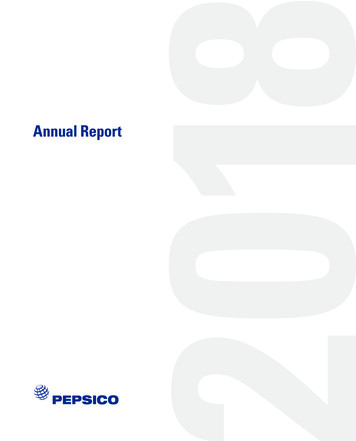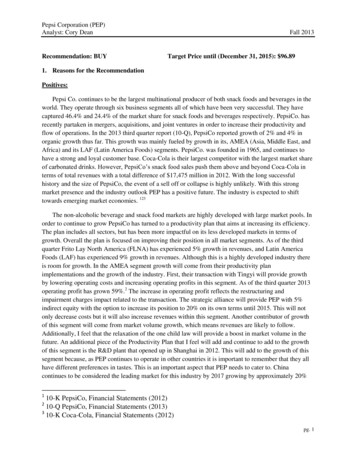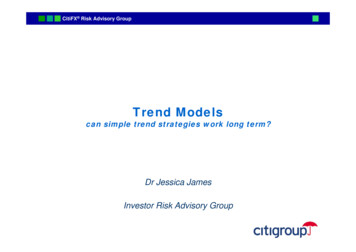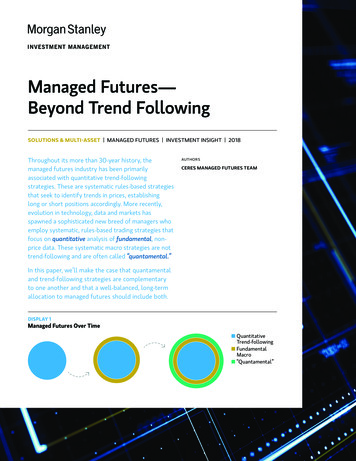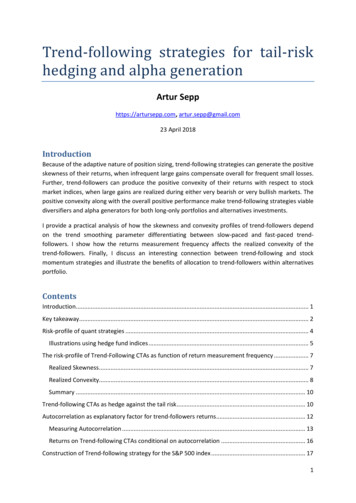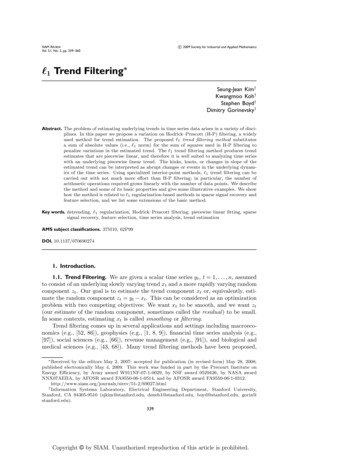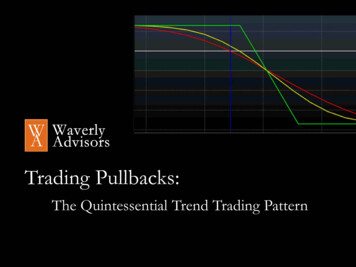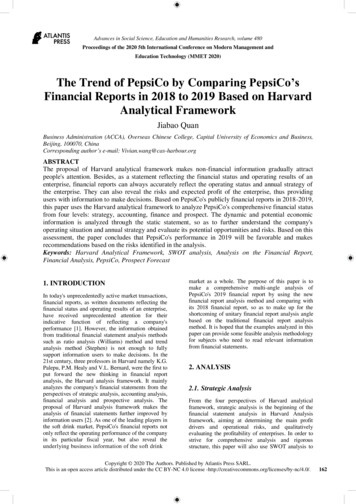
Transcription
Advances in Social Science, Education and Humanities Research, volume 480Proceedings of the 2020 5th International Conference on Modern Management andEducation Technology (MMET 2020)The Trend of PepsiCo by Comparing PepsiCo’sFinancial Reports in 2018 to 2019 Based on HarvardAnalytical FrameworkJiabao QuanBusiness Administration (ACCA), Overseas Chinese College, Capital University of Economics and Business,Beijing, 100070, ChinaCorresponding author’s e-mail: Vivian.wang@cas-harbour.orgABSTRACTThe proposal of Harvard analytical framework makes non-financial information gradually attractpeople's attention. Besides, as a statement reflecting the financial status and operating results of anenterprise, financial reports can always accurately reflect the operating status and annual strategy ofthe enterprise. They can also reveal the risks and expected profit of the enterprise, thus providingusers with information to make decisions. Based on PepsiCo's publicly financial reports in 2018-2019,this paper uses the Harvard analytical framework to analyze PepsiCo's comprehensive financial statusfrom four levels: strategy, accounting, finance and prospect. The dynamic and potential economicinformation is analyzed through the static statement, so as to further understand the company'soperating situation and annual strategy and evaluate its potential opportunities and risks. Based on thisassessment, the paper concludes that PepsiCo's performance in 2019 will be favorable and makesrecommendations based on the risks identified in the analysis.Keywords: Harvard Analytical Framework, SWOT analysis, Analysis on the Financial Report,Financial Analysis, PepsiCo, Prospect Forecast1. INTRODUCTIONIn today's unprecedentedly active market transactions,financial reports, as written documents reflecting thefinancial status and operating results of an enterprise,have received unprecedented attention for theirindicative function of reflecting a company'sperformance [1]. However, the information obtainedfrom traditional financial statement analysis methodssuch as ratio analysis (Williams) method and trendanalysis method (Stephen) is not enough to fullysupport information users to make decisions. In the21st century, three professors in Harvard namely K.G.Palepu, P.M. Healy and V.L. Bernard, were the first toput forward the new thinking in financial reportanalysis, the Harvard analysis framework. It mainlyanalyzes the company's financial statements from theperspectives of strategic analysis, accounting analysis,financial analysis and prospective analysis. Theproposal of Harvard analysis framework makes theanalysis of financial statements further improved byinformation users [2]. As one of the leading players inthe soft drink market, PepsiCo's financial reports notonly reflect the operating performance of the companyin its particular fiscal year, but also reveal theunderlying business information of the soft drinkmarket as a whole. The purpose of this paper is tomake a comprehensive multi-angle analysis ofPepsiCo's 2019 financial report by using the newfinancial report analysis method and comparing withits 2018 financial report, so as to make up for theshortcoming of unitary financial report analysis anglebased on the traditional financial report analysismethod. It is hoped that the examples analyzed in thispaper can provide some feasible analysis methodologyfor subjects who need to read relevant informationfrom financial statements.2. ANALYSIS2.1. Strategic AnalysisFrom the four perspectives of Harvard analyticalframework, strategic analysis is the beginning of thefinancial statement analysis in Harvard Analysisframework, aiming at determining the main profitdrivers and operational risks, and qualitativelyevaluating the profitability of enterprises. In order tostrive for comprehensive analysis and rigorousstructure, this paper will also use SWOT analysis toCopyright 2020 The Authors. Published by Atlantis Press SARL.This is an open access article distributed under the CC BY-NC 4.0 license 2
Advances in Social Science, Education and Humanities Research, volume 480analyze PepsiCo’ internal strengths, weaknesses andexternal opportunities and threats in the part ofstrategic analysis.2.1.1. StrengthsPepsi entered the market earlier than most of the othersoft drinks companies, therefore it has a greateradvantage in market operations [3]. In 2019, PepsiCo'sglobal market penetration rate reached 22.7%.Moreover, as a mature company, the profit brought bythe brand effect of PepsiCo can not be underestimated.Its strong innovation and product developmentcapabilities have enabled PepsiCo to expand itsproducts from soft drinks market to the entire foodmarket, as well as the footwear and clothing market,which has further increased Pepsi's market share andexpanded its brand influence. The brand propositionsand personalities promoted by Pepsi, such as "eager toinfinite", have huge market and loyal consumer groupsamong young consumer groups [4].market gap are beyond the satisfaction of the domesticmarket and the single soft drink market [6]. In addition,PepsiCo is making significant progress in sustainabilityjourney to catalyze change and help build a moresustainable food system that can meet 21st century needs[7]. This will give PepsiCo more opportunities tocooperate with the government and has a positive impacton Pepsi's brand image.2.1.4. ThreatsAlthough PepsiCo is a century-old company, its mainproduct, Pepsi-Cola, has always been threatened byCoca-Cola [8]. In addition, because of the profitabilityof Pepsi and Coca-Cola in the Cola market, newcompetitors may enter the barrier. In the greenenvironment, the main form of packaging (such asplastic bottles, cans, etc.) of Pepsi's products maybring negative effects such as tax increase.2.2. Accounting Analysis2.1.2. WeaknessesInfluenced by many factors, nowadays consumers'preferences in product selection have changed a lot.For example, the increasing attention people pay onhealth and the changing age structure of consumerscaused by the aging of the population may shrinkPepsiCo’s market. Therefore, the market growth rateof Pepsi cola, the main product of PepsiCo, may facea downward trend, and the market demand may alsodecrease [5]. On the other hand, PepsiCo's largeorganization means higher management costs andcontrol expenses, which will offset the profits madeby PepsiCo to some extent.2.1.3. OpportunitiesWith 140,000 employees in more than 200 countries,PepsiCo is the world's fourth-largest food and beveragecompany with annual sales of 27 billion. In 2005,PepsiCo’s "This is Pepsi" end revolution created theperfect sales point. In doing so, Pepsi has further expandedits markets around the world. Thanks to the tide ofeconomic globalization, Pepsi has obtained opportunitiesin many overseas markets, but such opportunities and hugeOn the basis of strategic analysis, accounting analysisaims to evaluate the extent to which accountingreflects the basic operating reality.2.2.1. Accounting PoliciesAs a famous listed company, PepsiCo is supervisedand required by NASDAQ and other relevantinstitutions, therefore the integrity, authenticity andaccuracy of its data and annual reports are largelyguaranteed. Its financial disclosure and informationdisclosure also have high reliability and credibility. Inits annual report disclosure of accounting policies, forinvestment, assets of revenue recognition contract,lease, revenue recognition, foreign currency, taxes,welfare costs, government support, borrowing costs,property, plant and equipment, intangible assets, assetimpairment, inventory, provision for bad debt andfinancial tools and other major accounting policies arecarried on the detailed instructions. Compare theaccounting policies with other same type companies,there is no obvious difference.2.2.2. Cash flowTable 1. Summary of Operations of PepsiCo in 2018&2019 [9].YearNet Cash Provided by Operating ActivitiesNet Cash (Used for)/Provided by Investing ActivitiesNet Cash Used for Financing ActivitiesNet (Decrease)/Increase in Cash and Cash Equivalents and Restricted CashCash and Cash Equivalents and Restricted Cash, Beginning of YearCash and Cash Equivalents and Restricted Cash, End of Year2019 9,649 6,437 8,489 5,199 10,769 5,5702018 9,415 4,564 13,769 112 10,657 10,769163
Advances in Social Science, Education and Humanities Research, volume 480It can be seen from the table that in 2018, net cashprovides by Operation is 9,415, which is 9,649 in2019. It is obviously that PepsiCo's operatingactivities in 2019 provide the company with morecash flow than that in 2018, which may mean thatPepsiCo gains more profits in 2019, or that PepsiCo'stransactions in 2019 are more paid in cash, while therevenue is reduced in the form of accounts receivable.Generally speaking, this situation indicates a successof PepsiCo's operating activities in 2019.Besides, the cash flow in investing activities ofPepsiCo in 2019 is negative, which is - 6,437. Onepossibility is that Pepsi failed to make an investmentin 2019 and the costs are more than profits; it couldalso indicate that PepsiCo has invested in one or morenew projects in 2019.In terms of financing activities, the cash flows in 2018and 2019 are both negative, which is - 8,489 and 13,769 respectively. It indicates that PepsiCo hascarried out a large number of debt-paying and profitdistribution activities in 2018 and 2019. It is alsopossible that the enterprise has sold certain assets andused the gain from disposal on financing activities.The cash flow of 2019 has increased compared withthat of 2018, which may indicate that PepsiCo hasobtained more capital inflows through the form ofstocks or bonds in 2019. This phenomenon may berelated to the expansion of the company's operationscale or the development of new production lines.From the other side, compared with the end of 2018,the amount of cash and cash equivalents and restrictedcash was down about 48% in the end of 2019,although this can be explained by the active degree ishigh, PepsiCo's cash source is abundant and themanagement of cash flow is good, but may also be thepotential risk that cash is in short supply.2.3. Financial AnalysisFinancial analysis aims to evaluate the company’soperating capability through some financial data andindicators.2.3.1. Solvency analysisTable 2. Consolidated Balance of PepsiCo, Inc. and Subsidiaries in December 28, 2019 and December 29,2018 [10].YearTotal Current AssetsTotal AssetsTotal Current LiabilitiesTotal Liabilities2019 17,645 78,547 20,461 63,679According to the table, the total assets in 2019 is 78,547 , which in 2018 is 77,648. The totalliabilities in 2019 is 63,679, and in 2018 is 63,046.Debt to asset ratio (2019) 63,679/ 78,547 81.07%(1)Debt to asset ratio (2018) 63,046/ 77,648 81.19%(2)Compared with 2018, the trend is down. From thestandpoint of creditors, this is a good trend, whichrepresents a small decline in the corporate risks thatcreditors have to bear, an improvement in thecorporate debt paying ability, and a decrease in thecorporate financing risks. From the perspective ofinvestors, on the premise that the profit rate of allcapital is higher than the interest rate of borrowedcapital, investors hope that the index will rise in orderto obtain higher income. From the perspective ofoperators, excessive amount of debt is difficult tofinance, and the decline of this index will facilitate2018 21,893 77,648 22,138 63,046enterprises to borrow more funds and expand themarket to improve profits and solvency.Current ratio (2019) 17,645/ 20,461 86.23% (3)Current ratio (2018) 21,893/ 22,138 98.89% (4)Generally speaking, companies are more stable whenthe current ratio is close to 2. However, whether in2018 or 2019, Pepsi's current ratio is far below 2.Considering the actual situation of Pepsi, onepossibility of this situation is that PepsiCo's cashsource is abundant and well managed, so it does notneed to reserve a large amount of capital. It may alsobe that PepsiCo is keeping a good control on thegrowth rate of accounts receivable and inventory. Thedownward trend in current ratio reflects the fact thatPepsiCo's inventory backlog in 2019 is likely toexceed that in 2018, with reduced liquidity of cashflow and the risk of a decline in short-term solvency.2.3.2. Profitability analysis164
Advances in Social Science, Education and Humanities Research, volume 480Table 3. Consolidated financial data of PepsiCo in 2018&2019 [11].YearNet revenueProvision for/(benefit from) income taxes (a)Net income attributable to PepsiCo (a)Net income attributable to PepsiCo per Common share–basic (a)Net income attributable to PepsiCo per Common share–diluted (a)Cash dividends declared per common share(a)2019 and 2018 results included the impact of theTCJ Act. Additionally, 2018 results included other nettax benefits related to the reorganization of PepsiCo'sinternational operations.It can be seen from the table that PepsiCo had netrevenue 67,161 in 2019, which is 64,661 in 2018. Itindicates that PepsiCo had higher net income in 2019than that in 2018. Besides, net income attributable toPepsiCo is significantly lower than that in 2018,indicating that the return generated from PepsiCoinvestment is lower than that in 2018. This situationsupports that the information that in the accountinganalysis, according to the cash flow statement forinvestment activities of cash expenditure wasincreasing compared. This suggests that PepsiCo'snew investment choice in 2019 may be failure. Inaddition, another possibility is that PepsiCo wasdevelop new investments in 2019, and the project hasnot yet reached the stage where it can recoup themoney. But overall, the cash dividends per commonshare rose in 2019 compared with 2018, meaning theprice on PepsiCo's shares was increased and the totalprofit was higher than 2018. In other words, althoughPepsiCo may fail in investment activities in 2019, itsoverall operation is still better than 2018, and itsoverall profitability has also improved. Therefore, theprofitability of PepsiCo is still reliable and stable.2.4. Prospect AnalysisProspect analysis mainly emphasizes the possibletrends of the company.2019 67,161 1,959 7,314 5.23 5.20 3.79252018 64,661 3,370 12,515 8.84 8.78 3.5875In addition, in nowadays' economic globalization,multinational companies have accelerated the processof internationalization, and PepsiCo may also try toseize the opportunity to rapidly develop and expandoverseas markets and actively promote thelocalization of products, which can also help PepsiCoto increase the global market share. From this point ofview, Pepsi is also likely to gain more opportunitiesand greater profits in overseas markets in the future.From the perspective of long-term development, thedevelopment prospects of PepsiCo in overseasmarkets are undoubtedly potential.Besides, in view of Pepsi's excellent solvency andprofitability, PepsiCo may further increase the cashflow used for investment in the future, which may alsobe an opportunity for Pepsi's profitability, but mayalso be a potential risk.2.4.2. Risk PredictionAs mentioned above, with the development of theconcept of green and healthy, PepsiCo's mainproducts are facing the risk of a decline in marketdemand. At the same time, the concept ofsustainability has also influenced Pepsi's brand image.The development of new products that cater to themarket and the transformation of corporate image notonly require a lot of funds, but also will face greatrisks and market uncertainty. These potential riskfactors are likely to affect PepsiCo's operatingperformance and profitability in the new quarter.3. CONCLUSION2.4.1. Prospects for DevelopmentIn the face of rapid market changes and fiercecompetition, Pepsi should make full use of big data,effectively organize internal management and externalsuppliers, and quickly respond to project time and costbudgeting [12]. This will save PepsiCo moreoperating expense and offset the negative impact thatmay be caused by the decrease of cash holdings thatanalyzed in accounting analysis and financial analysis.It can be seen from the analysis of Harvard analyticalframework that the current operation capacity,development space and prospect of PepsiCo are veryreliable. The company has sufficient sources of funds,good internal management and control, and stable andexcellent solvency and profitability. Compared with2018, the majority of indicators for 2019 showed apositive trend. In addition, PepsiCo has also beenactively exploring overseas markets to obtain moreopportunities, and has achieved some success at thisstage [13].165
Advances in Social Science, Education and Humanities Research, volume 480In order to deal with the concept of sustainabledevelopment and the concept of green and health, it issuggested that PepsiCo put forward the greendevelopment goal next year to build a positive brandimage. PepsiCo can also develop new products tomeet diversified market demands.However, the Harvard analytical framework used inthis paper also has some shortcomings. Harvardanalytical framework is more about analyzing acompany's ability and potential from the perspectiveof operational data. However, a company's strengthsand weaknesses are not only reflected through data.Non-data indicators, such as employee enthusiasmand corporate culture, also play an important role inthe growth of a company. When the analysis of acompany combines the Harvard analytical frameworkwith non-data factors, the understanding of a companycan be more complete and more accurate.ACKNOWLEDGMENTFirst of all, I would like to show my deepest gratitudeto my professors and teachers who have provided somany valuable suggestions for my thesis. Further, Iwould like to thank my classmates for theirencouragement that enabled me to persist incompleting this paper.REFERENCES[1] D. Zou. Analysis of Corporate FinancialStatements [J]. China Business Theory, 2020(07):159160.[2] Palepu, Healy, and Bernard. Business Analysis &Valuation: Using Financial Statement[M]. Southwestern College Pulishing.2000[3] Y. Xiang. Challenging the Strong - Pepsi cola'sMarket Competition Strategy [J]. China High-techZone, 2008, 000(009):108-111.[4] W. Chen. "Pepsi Cola cool to the End" [J]. ChinaHigh-tech Zone. 2007(11)[5] X. Yang. Localized Marketing of Pepsi Co. [D].East China University of Science and Technology,2014. P11-12[6] C. Zhang. Research on the Experience of InferiorEnterprises overcoming superior Enterprises - A Casestudy of the hundred-year Competition between 5-208.[7] N. Zheng. PET plastic recycling economy built byPepsiCo [J]. Polyester industry, 2019, 32(01):24. (inChinese)[8] X. Liu. Research on Brand Symbols [D]. ShanghaiUniversity, 2014. p32[9] PepsiCo public annual report in 2019[10] PepsiCo public annual report in 2019[11] PepsiCo public annual report in 2019[12] G. Yang. Research on Big Data TechnologyApplication and Implementation Management ofPepsiCo [D]. Tianjin University of Finance andEconomics, 2014, P42-43[13] PepsiCo: growth of 3% this year [J]. Board ofDirectors, 2017(05):11.166
Coca-Cola [8]. In addition, because of the profitability of Pepsi and Coca-Cola in the Cola market, new competitors may enter the barrier. In the green environment, the main form of packaging (such as plastic bottles, cans, etc.) of Pepsi's products may bring negative effects such as tax increase. 2.2. Accounting Analysis


